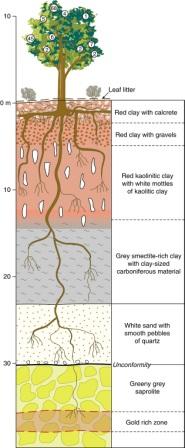 Geobotanica is the science that studies the relationship between geography and vegetation. Included the relationship between plants and (underground) minerals. The use of plants to find ore bodies is called geobotanical prospecting. Also for oil and gas exploration, drilling, and tar sand and oil shale mining.
Geobotanica is the science that studies the relationship between geography and vegetation. Included the relationship between plants and (underground) minerals. The use of plants to find ore bodies is called geobotanical prospecting. Also for oil and gas exploration, drilling, and tar sand and oil shale mining.
The Chinese have geobotanical description stemming from several hundred years before our era. They used this knowledge to find metals.
Viola calaminaria and especially penny-cress (Thlaspi) are zinc -loving.
Alyssum (Alyssum bertolini) could withstand high concentrations of nickel.
Cock spur (or barnyard) Grass (Panicum crus galli) indicates the presence of lead.
Knotweed loves hematite (iron oxide).
Coarse chives lust silver.
Ginger is on copper and tin.
Siai and Hwei - t'ang indicates gold ore. And of this was of course no translation found.
None of this ancient Chinese evidence has been tested and proven to my knowledge. A scientific field in which is still a lot of work to do apparently.
A faithful indicator plant is Ocimum centraliafricanum, the "copper plant" (- flower) found only on copper (and nickel) containing soils in central to southern Africa.
Copper and nickel accumulate also in Helichrysum candolleanum and Blepharis diversispina.
The Alpine Catchfly (Alpine campion, (Lychnis alpina)) with pink flowers has been used since the Middle Ages to find copper. Modern research has discovered that this type is genetically resistant to the metal, so that they thrive in the soil where the presence of copper ore makes life for other plant impossible.
The Viscaria Mine in Sweden is named after the flower Viscaria Alpina, used by prospectors to discover the ore deposits.
Heavy metals are accumulated by Rumex acetosella L. (sheeps’s sorrel) and Minuartia verna (L.) (spring sandwort).
There are also projects to accumulate heavy metals and extract.
I assume that plants also adapt regionally across generations, and that they are not found in the same (amount of) existing metals / minerals points ..
An amazing example is the western spiderwort (Tradescantia occidentalis) : blue stamens in its flowers change to a pink when radiation is present in the environment.
Pandan or screw palm (Pandanus candelabrum) is an up to 10 meter high palm-like with an above-ground root system similar to that of mangrove trees. It grows on kimberlite rich soil, with a high content of magnesium, potassium and phosphorus. Which occur in vertical pipes of volcanic rock with a diameter of hundreds of meters. Where this tree grows diamonds can be found. There are about 6,000 known places in the world. Only about 600 of them contain diamonds, and only 60 have sufficient gems to start mining.
